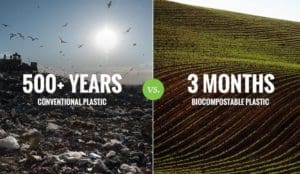
The world is awash in traditional, petroleum-based plastics that are choking our waterways and filling up our landfills. Here at UrthPact, we’re committed to compostable plastic products, providing manufacturers and consumers with the plastics they want and need, but created using environmentally-friendly, biodegradable raw materials that can be safely composted to nourish the earth.
Today, in addition to the conventional backyard compost pile or bin that can efficiently handle small amounts of waste materials from lawns, gardens and kitchens there are industrial composting facilities designed to effectively process large volumes of municipal and commercial waste.
There are basically three techniques used in industrial composting: windrow, in-vessel, and aerated static pile composting. Windrow composting is an open-air process that places the composting material into long piles approximately 5 feet high called “windrows.” These windrows are turned regularly to ensure that all the composting materials spends some time in the warm, moist center of the pile where bacterial activity produces heat that encourages further breakdown. Because windrow composting is on open air process, it is used primarily for yard and garden waste to help control odor.
In-vessel composting, however, is a process that takes place in an enclosed environment. In-vessel composting can process large amounts of waste without taking up as much space as the windrow method and it can accommodate virtually any type of organic waste — meat, animal manure, bio-solids, and food scraps, for example. This method involves feeding organic materials into a drum, silo, concrete-lined trench, or similar equipment. This enables efficient control of environmental conditions such as temperature, moisture, and airflow. The material is mechanically turned or mixed to make sure the material is aerated to encourage bacterial activity. The size of the vessel can vary in size and capacity.
In-vessel composting takes a few more weeks or months until it is ready to use because the microbial activity needs to balance and the pile needs to cool. The waste is left in these vessels for seven days and temperature probes ensure that there is sufficient heat to kill any dangerous bacteria – it must achieve a temperature of 140°F for at least two continuous days. The waste is then transferred to a maturation pad for the final stage of composting.
Aerated static pile composting produces compost relatively quickly, generally within three to six months. It is suitable for a relatively homogenous mix of organic waste and work well for larger quantity generators of compostable municipal such as government agencies and commercial food operations solid waste such as food scraps, paper products, and bioplastics.
In aerated static pile composting, organic waste is mixed in a large pile. To aerate the pile, layers of loosely piled bulking agents such as wood chips, shredded newspaper are added so that air can pass from the bottom to the top of the pile. The piles also can be placed over a network of pipes that produces airflow in and out of the pile using air blowers that can be activated by a timer or temperature sensors.
These large-scale, centralized composting facilities can serve wide geographic areas and divert significant amounts of organic materials from waste disposal facilities where they would instead be buried or burned. Their potential impact should not be underestimated. According to a study done by the Institute for Local Self-Reliance, a nonprofit sustainable community advocacy organization, 78 million tons of municipal waste (food scraps, yard trimmings, soiled paper, wood waste, and some bioplastics) currently head to US landfills annually instead of to composters where approximately 21 million tons of usable compost material could be recovered and utilized.
Industrial composting produces more than just high quality compost for soil remediation. It also produces jobs, a greener environment, enhanced food security, less waste, and less truck traffic hauling garbage. All the more reason for manufacturers and retail businesses alike to join us in supporting composting on every level.
If you’re a manufacturer looking to switch from non-sustainable, petroleum-based traditional plastics to eco-friendly bioplastics, contact us today to talk about converting your injection-molded products into compostable plastics.



